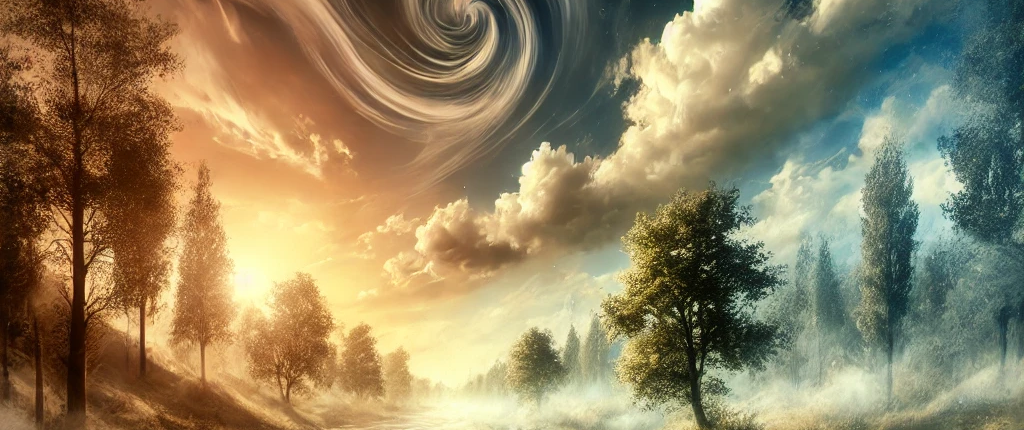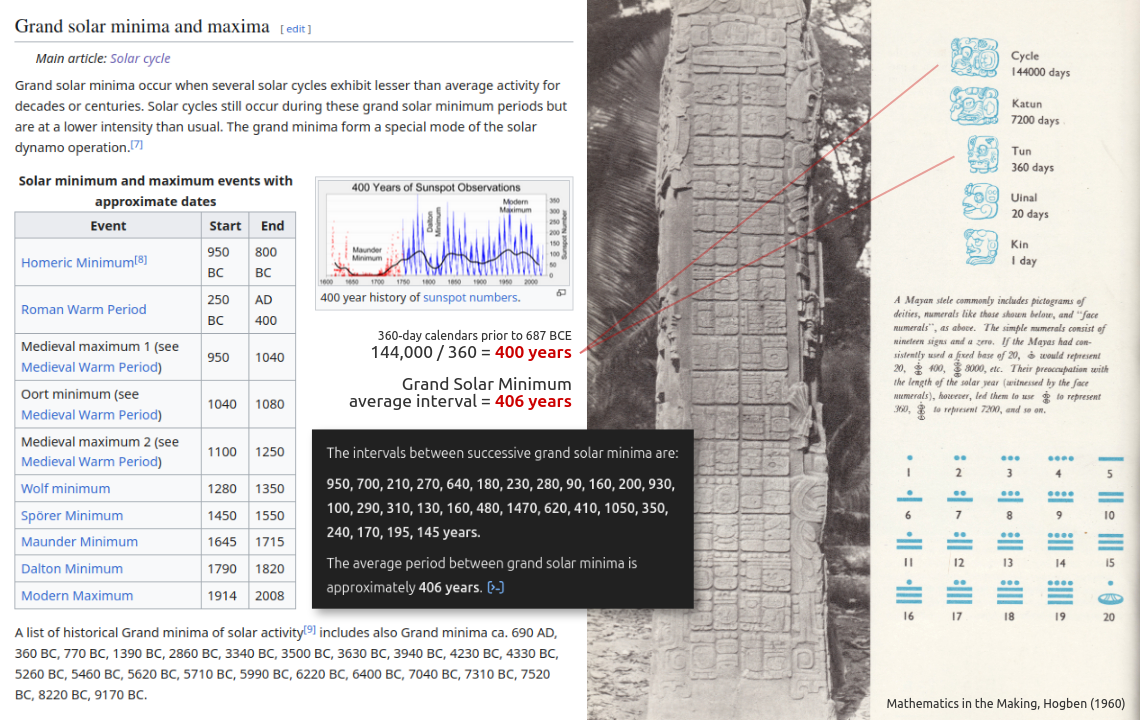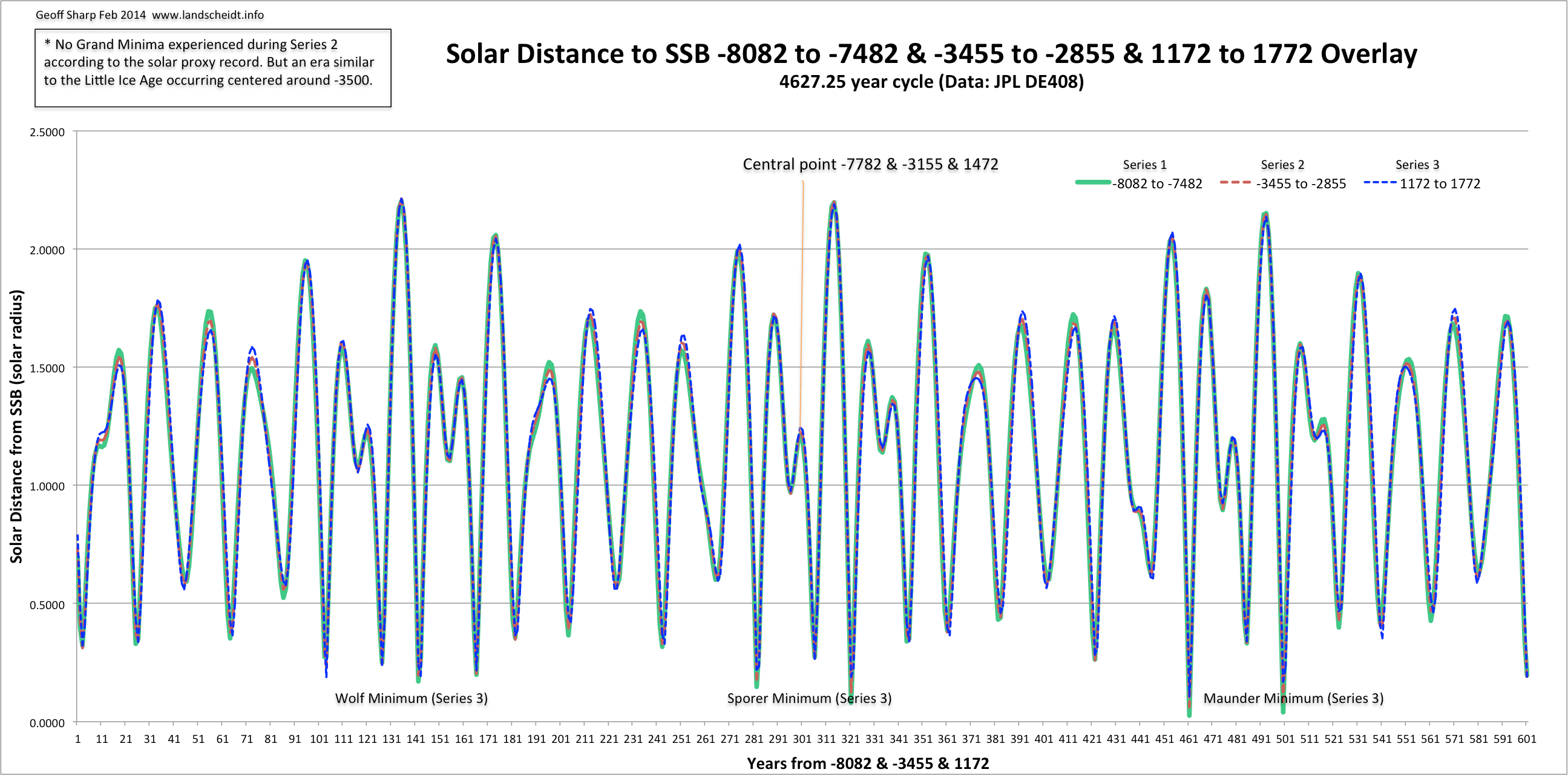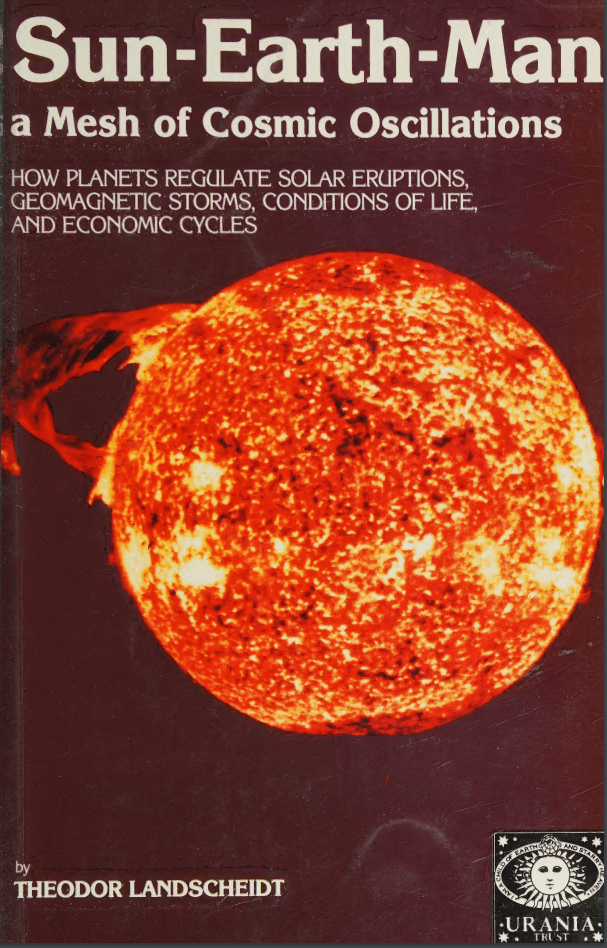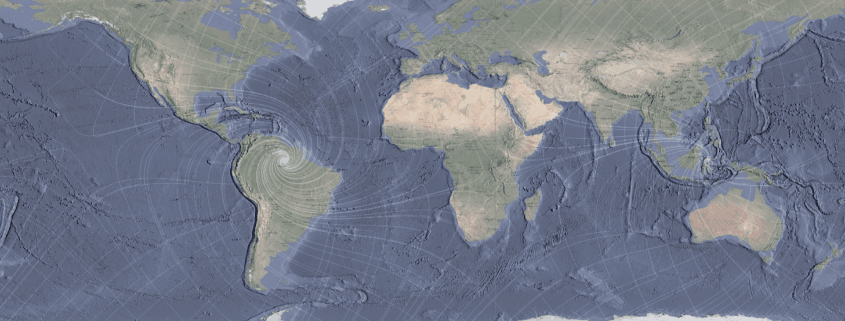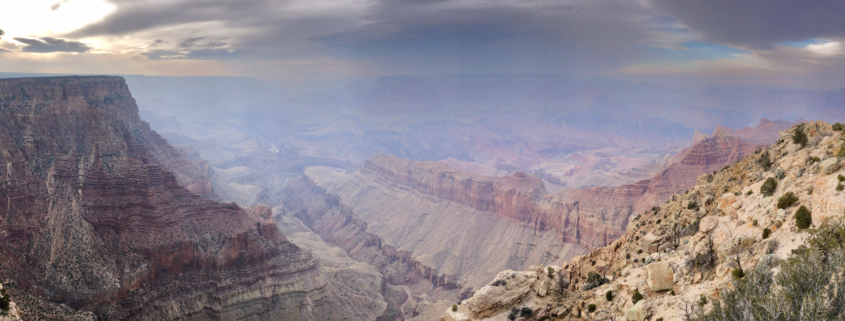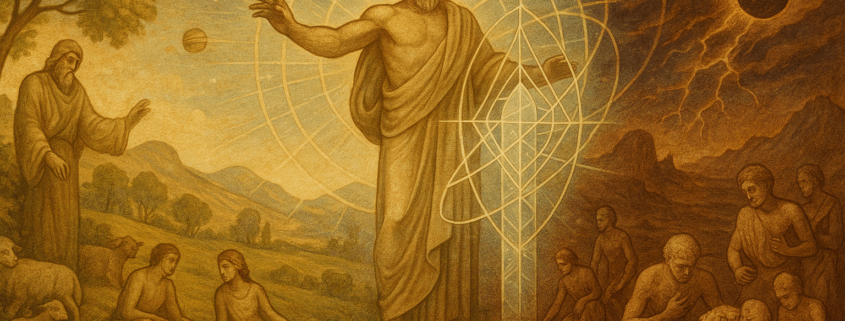“Everything flows, and nothing abides; everything gives way, and nothing stays fixed.” – Heraclitus
Contents
ABSTRACT
Beat frequencies, synodic periods, or lap rates of the outer planets and their harmonics dominate spectra of solar angular momentum and sunspot activity, and the inner planets are not only commensurable but also contribute dynamically. Analogous beat frequencies and harmonics characterize the Earth-Moon motion and tidal potentials.
The two barycentric systems are interrelated and their periodicities are commensurable; thus, additional beat frequencies develop between the Sun and Earth-Moon pair.
The 6.2-yr Chandler Wobble beat is one third of the 18.6-yr nutation period and one tenth of the 62.013-yr perigee-syzygy-perihelion tide cycle. The principal periods or “recurrence intervals” of both systems appear in terrestrial climate spectra, e.g. in long-term tree-ring series and other proxy data (important periods: 4.4, 6.2, 8.85, 11.08, 13.34, 18.03, 18.6134, 19.859, 22.24, 31.008, 45.369, 55.8, 59.6, 62.103, 83.4, 88.13, 93.2, 111.02, 167.5, 171.4, 178.73, 179.33, 186.1, 222.1, 208.53, 230.09, 297.8, 317.7, 417.04, 558.12, 575.3, 744.5, 893.6, 953.24, 1679.2, 2224.2, 2680, 2859.7, etc.). Most of the planetary and lunar periodicities are commensurable with an outer planetary alignment of 4627.15 yr and with a more comprehensive one of 93,418 yr.

Orbital period first order resonances between solar system bodies (<1% variance).
1. Introduction
When dealing with fundamental processes relating to Planet Earth, to begin with it would be helpful perhaps for physicists and others who have not been nurtured on the “folklore” of fossils, strata and historical geology, to consider what have been synthesized as the “Four Earth Laws” (Fairbridge, 1980). These are:
- Law of Finite Existence. (Our planetary system is very precisely constrained in terms of material, mass, space and time, and is solar dependent.)
- Law of Physical Evolution. (Our planet Earth has evolved cyclically, but irreversibly, in threshold steps, progressively leading towards a gravitational ordering of materials; despite an entropy tendency, it always seems to preserve some vestiges of its past accumulations and revolutions.)
- Law of Organic Evolution. (Since the first appearance of self-reproducing molecules, living organisms have evolved in an expanding, continuous and uninterrupted sequence; notwith- standing periodic and catastrophic mortality no major phylum has ever become extinct.)
- Law of Dynamic Equilibrium. (In spite of cyclic fluctuations, a status quo is constantly maintained by feedback in all terrestrial systems; isotopic states are time-constrained. Thus the mean temperature of planet Earth has remained at 18+/-5°C for 4 billion yr and equatorial sea-surface temperature remains at 30+/-1°C. (For the last reason, some of the more exotic CO-2 scenarios for the 21st century are not to be taken seriously.)
Our solar system has survived in a quasi-stable state of equilibrium since the early phases of its initial formation about 4.6 to 4.0 billion yr ago, subject to two categories of energy transfer: (a) gravitational (although total angular momentum of sun, planets and their satellites is conserved, they are subject to both rotational and orbital changes in velocity and thus exchanges of momentum); and (b) radiational, from the Sun (both particulate and electromagnetic).
All discrete components in the system, sun, planets and satellites, possess separate attributes of motion: orbital (“revolutions”), and rotational (“spin”), as well as differential motion within each major body (the compositional “processes”). Each body is somewhat oblate and develops an equatorial bulge, so that with its spin axis tilted in varying degrees to its orbital plane it is subject to tidal attraction resulting in an orbital precession. The entire system, as well as each subsystem (planets with satellites), is in motion about a barycenter, the locus of which is the circum-galactic orbit. For the planets and satellites, the orbits are ellipses and conform to Kepler’s laws; however, the Sun’s orbit is an inertial system (non-Keplerian) and follows a pattern of successive epitrochoids and cardioids, in a precessing sequence of larger and smaller loops.
The Wobble of the Sun. Solar-SSB (Solar System Barycenter) displacement over time as influenced by the planets.
2. The Pulse of the Solar System
For the inhabitants of Planet Earth two of these barycentric systems are of overwhelming importance. First is the Sun with its planetary system playing the dynamic role of satellites, in a way analogous to a highly asymmetric twin star, both waltzing around its barycenter which maintains a steady trajectory around the galaxy (Fairbridge & Sanders, 1987). And the second is the “twin-planet,” our Earth-Moon Pair, unique in the solar system for its unusual mass ratio, 80:1.
Inasmuch as Jupiter and Saturn possess 86% of the system’s angular momentum, their conjunctions, which occur about every 20 yr (SJL, the Saturn-Jupiter Lap: 19.859+/-0.82 yr), constitute the fundamental “Pulse of the Solar System” (Fairbridge & Sanders, 1987; independently confirmed by Jakubcova and Pick, 1987; Charvatova, 1990).
Further input into the system is provided by the Uranus-Saturn Lap (USL, 45.368 yr), the Neptune-Uranus Lap (NUL, 171.43 yr), the double synod (USL/SJL, every 317.7 yr). These synods occur within 1-2 yr, but at different longitudes), and many other combinations take place. The periods of the synodic pairs (“laps”) constitute beat frequencies of their revolution periods which may be calculated by a simple formulation:
BF = Po x Pi (Po – Pi)1
(where P = planetary period
o = outer, i = inner planet
The sunspot triggering force on the solar surface has long been controversial. Inasmuch as the Sun is a spinning body as well as having an inertial orbit, a weak torque should be applied by the planets at their synods (Landscheidt, 1988). The principal gravitational potential (certainly a weak one) is shared between Jupiter, Earth and Venus (JPV Lap = 5.550 yr). Wolff & Hickey (1987) attribute the solar irradiance variation to inertial oscillations which develop beat frequencies. Spectral analyses of sunspot number variance disclose corresponding periods (Currie, 1973; Cole, 1973). These periodicities are found also in solar flare frequencies. Very high energy solar flare activity has considerable variance but the mean period is 13.34 yr (Landscheidt, 1988).
The mean sunspot cycle is about 11.12 yr, but it varies in length appreciably (+/- 6 yr from mean to maximum) and systematically over the course of a 178.71 yr cycle (Fairbridge & Hameed, 1983). In general, the shorter the sunspot cycle, the higher the numbers and conversely, a fact discussed already by Clough (1905). Schwentek and Elling (1984) calculated a set of periodicities based on the ratios of the distances from the Sun of the major planets, which would force comparable stress cycles on the photosphere, and would necessarily vary over long periods. A distinctly bimodal development is found in solar cycle length, mentioned above but the familiar 11.12-yr period also appears in spectra and may not be merely an average (Wilson, 1987).
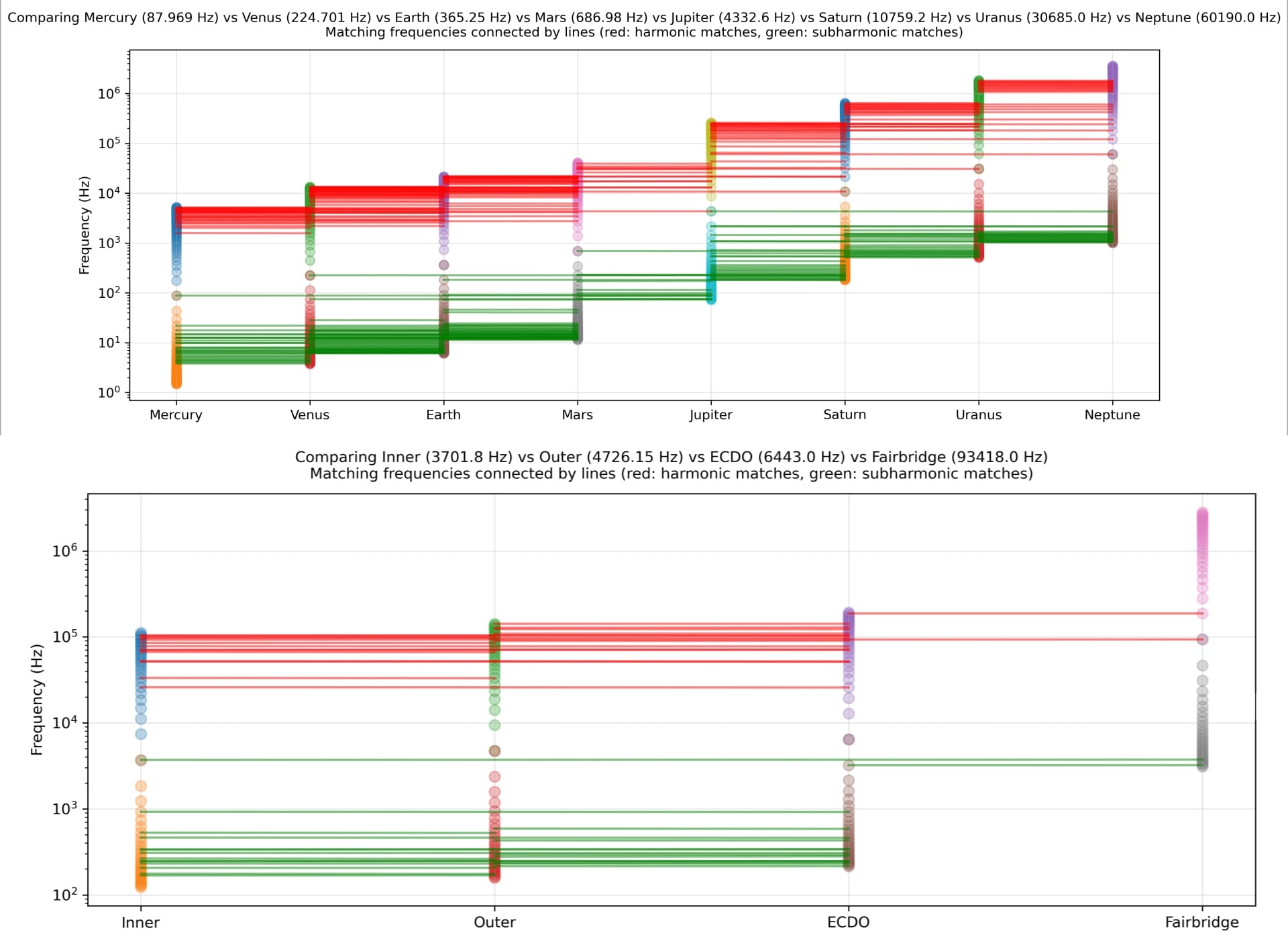
A harmonic comparison of the first 30 superior and inferior harmonics between the inner planets (Me-Ve-Ea(m)-Ma-Ju-Sa) and the outer group (Ju-Sa-Ur-Ne) which fall within a 1% degree of variance. The dominant 5:4 harmonic is among the most defined in our solar system [1]. When compared to these inner and outer periods, the 6443-year period proposed by @EthicalSkeptic exhibits a strong 7:4 primary resonance to the Inner planets (which happens to be the precessional period of 25912 years!)[2] and a similarly strong 7:5 resonance with the four outer planets [3]. Stacking these up against the precessional period and the grand cycle of (93418 years – Fairbridge) it becomes apparent that the 6443 period has a strong resonance to all of the other major orbital cycles in our Solar System.
3. The Earth-Moon Pair
In the case of the “twin planet”, the Earth-Moon Pair, the fundamental period is the so-called 28-day lunar month (27.3216 days), which also represents the geodynamic “pulse” for many terrestrial physical and biotic systems, just as the 20-yr period does for the Sun. The Earth’s spin axis turns gyroscopically about a cone in space with a primary period of 25,730 yr leading to a counter-clockwise precession of the equinox. More important perhaps in human terms is the nutation of that axis (by about 9 seconds of arc) in 18.613 yr, which reflects the nodal regression (a clockwise gyroscopic motion) and declination period of the lunar orbit. Both phenomena and its role have been known since the time of Meton about 450 BC.
In the Moon’s motions there exist a very large number of components, but the important ones combine at a period of 744.5 yr (so-called “Gabriel Period”, after its discoverer). It provides us with an important link with the drift period of the Jupiter-Saturn Resonance position (18 x 744.5, or 720 x 18.613 = 2680 yr). The fundamental Lunar-Planetary Beat Frequency is 297.8 yr (16 x 18.613 and 15 x 19.86 yr). It relates commensurably with all the major Planet-Sun+Earth-Moon periodicities; thus, in simple ratios, if 1 = 297.8 yr, 3 = 893 yr, 9 = 2680 yr, 45 = 13,401 yr. It is clear therefore that the Earth-Moon motions are precisely integrated into those of the Sun and the other planets.
The most powerful luni-solar resonance is generated by the SJL and the Earth’s nutation; thus 15 x 19.86, or 16 x 18.613 = 297.8 yr, with the last approximately in-phase epoch between AD 1802.3 and 1801.7. Commensurability of the Chandler Wobble beat frequency provides for extrapolated estimates (48 x 6.2 = 297.8 yr). A simple expansion (9 x 297.8 = 2680 yr) provides a direct link with the drift period of the Jupiter-Saturn Resonance position, which in turn is commensurable with other major planetary periods such as the 178.7 yr cycle (Sun’s orbital symmetry progression: 15 x 178.7 = 2680 yr), and the USL (59 x 45.36).
An “Outer Planet Restart Cycle” recurs at intervals of 4627.15 yr (= 233 x 19.859, or 102 x 45.36, or 27 x 171.39). It is primarily an outer planet relationship but is commensurable with the inner planetary and lunar periods. North and Schlamminger (1979) drew attention to many of these relationships, including paired synods (e.g. Jupiter+Saturn with Uranus+Neptune: 22.46 yr) and even quadruple commensurability (Venus+Earth+Mars+Ceres with Jupiter+Saturn+Uranus+Neptune: 3.75 yr). Very many of the planetary and solar periodicities find a common denominator at 93,418 yr.
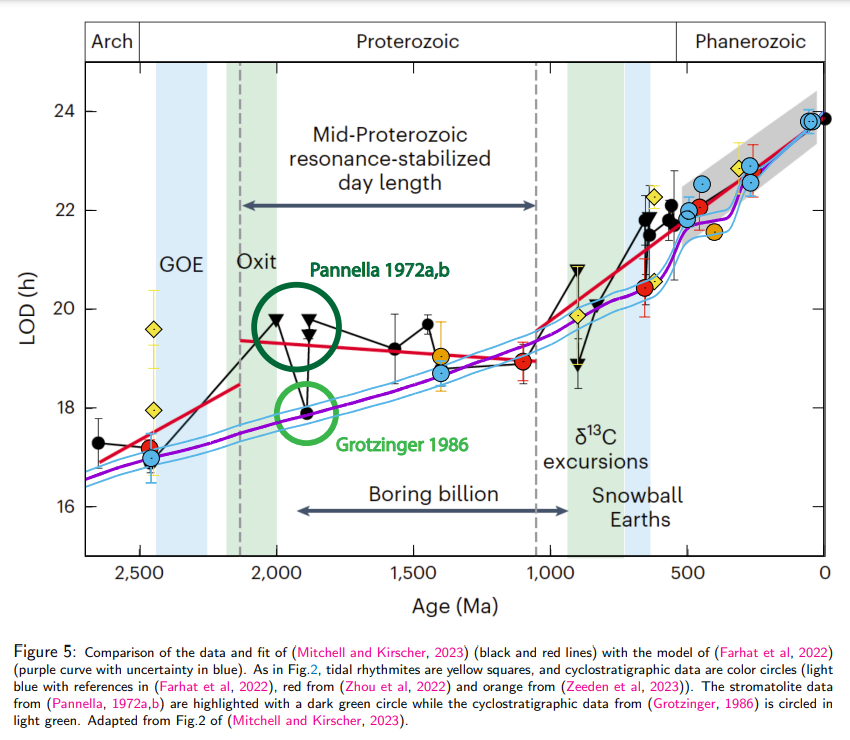
Changes in the Length of Day (LOD) over the past 2.5 billion years. Source.
4. Geophysical, Geological and Paleoclimatological Links
The most prominent short-term geophysical signals of exogenetic (astronomic) origin are measured in the geomagnetic field moment, only about 50% of the latter being endogenetic. The Earth’s spin rate (conversely the LOD, length-of-day), with parallel fluctuations in the magnetic field shows a seasonal variance commonly ascribed to wind stress and other climatic factors. Sudden jerks in the spin, however, are directly associated chronologically with high-energy solar flare events, also often reflected by magnetic storms (Alldredge, 1984). Many cycles of the 11-22 yr sunspot periodicities have now been traced in the magnetic records since they were first noticed in the middle of the 19th century. Harmonics of the annual variation were calculated by Currie (1974).
As mentioned above, the 18.6-yr nutation period, as well as shorter lunar cycles, are also recognized in the magnetic observations. The coincidence between aurora borealis behavior and the various moon-related periodicities was investigated in Sweden already in the last century (Ekholm & Arrhenius, 1898), showing a clear geomagnetic link. They also discussed parallel climatic events, notably thunderstorm incidence which intrinsically implies some relationship to the atmospheric electrical systems. After 90 years the question is still controversial. In view of the physical linkage between the latter and precipitation it is reasonable to take seriously the proposals by Markson and Muir (1980) and others, as well as many pioneering (and certainly inexpert) correlations which have been subjected to vehement and largely unproductive criticisms by Pittock (1978, 1983). While critical study is essential, it is hardly ethical to condemn without undertaking positive investigative steps.
Studies of upper atmospheric chemistry and aeronomy in general disclose interactions initiated by the two principal variants in solar emissions: the extreme UV flux and the particulate radiation flux. Although the former is tied to the 11-22 yr solar cycles, the latter shows only a very rough correlation with it at mean peak levels, sometimes as much as 4-6 yr after the sunspot maximum. The UV flux provides an external source for ozone generation in the stratosphere, where it behaves as the major “greenhouse gas”, but the level is modulated also by rates of downward dissipation and reaction rates with other gases which in recent decades include anthropogenic pollutants.
Ozone has been measured in the troposphere at high elevations, e.g. Arosa in the Swiss Alps since the 1920’s (Dutsch, 1979; Kane, 1988), and in the stratosphere by rockets since World War II, providing an admittedly spotty record but spanning several solar cycles. Spectral analysis of solar activity show some interesting correspondence with ozone, e.g. a 3.7 yr peak (which is the beat frequency between the combined inner planets and combined outer planets: Wörth & Schlamminger, 1979), a 6.2 yr peak (the Chandler beat), and the 10-11 yr sunspot periods. Ozone also shows the QBO at 2-3 yr intervals (Oltmans & London, 1982).
The lower stratosphere and tropopause also fluctuate in height, not only through the solar cycle, but in connection with the seasonal shift of upper-air wind direction. Coy (1979) showed that above a given site in the west latitudes there is a 6 month (E-W) wind reversal at about 40-70 km elevation but it breaks up around 40 km, and reaching down to around 16 km, it passes into the well-known Quasibiennial Oscillation (QBO) that averages about 2.2 yr. The upper air flow is generally westerly and the lower easterly, but over the course of 12 months or more distinctive tongues of westerlies descend to about 16-20 km, e.g. 1972, 1974, 1976. Schove (1983) has shown that the QBO is present in many terrestrial climate proxies (weather, tree rings, varves, etc.) and is most prominent during the high sunspot maxima intervals; in contrast, during low activity periods the QBO may be replaced by a weak Quastriennial Cycle (QQO). We note that 5 x 2.166 = 10.83 yr (high solar activity mode), and 4 x 3.066 = 12.266 yr the low activity mode. The distribution of QBO/QTO intervals over past centuries can be used as a fine-tuning vernier for establishing identical chronologies in long-distance teleconnections (Schove, 1978; reprinted in 1983). In recent analysis of general circulation models existence has been found of both the QBO (Currie & Hameed, 1988) and of the Southern Oscillation (Sperber et al., 1987).
The problem with contemporary geophysical and geochemical data is that they provide “snap-shot” observations or at best time series which extend only a few decades, so that linkage with the outer planetary motions is excessively difficult, in view of their long periods. As mentioned above, the “Outer Planets Restart” period is 4627 yr, and even an important lunar cycle is 558 yr. One of geology’s fundamental methodological axioms is the Principle of Actualism: we appraise and interpret the past on the basis of physical observations of processes actually occurring at the present time, although acknowledging a corollary to the Fourth Earth Law: the recognition of violent chaotic departures from time to time from the “normal” equilibrium that is then re-established by the various feedback mechanisms.
5. Climatic Proxies
In order to forge a link between 20th century observational geophysics and meteorology, it is necessary to establish “climatic proxies” (Lamb, 1977). Historical proxies are furnished by documentary evidence such as times of freeze-ups, cherry-blossom flowering, harvest statistics, floods and droughts. Geological proxies are provided by any process involving layering or stratigraphy; they fall roughly into two time frames: those less than 10,000 yr (e.g. tree rings, ice accumulations, lake-varve sediments, beach—dunes) and those of greater length (e.g. ice age sediments and morphology, major climatogenic sediment types such as coals, redbeds, evaporites).
Intrinsic in these studies is the establishment of a “normal”, from which departures can be dated and measured. In the long-term framework one of the major discoveries, at least for this writer (Fairbridge, 1973), was that ice ages are unusual events of geologic history. They recur at intervals of perhaps 130-260 million years, which possibly corresponds to the solar system’s passage through the spiral arms of the galaxy. Each major ice age lasts about 10-20 myr and is thus occupying a “spike” representing less than 10% of total geologic time. But even within this 10% glacial cycles alternate at 40,000 to 100,000 yr intervals with interglacials, so that the full glacial intervals (“pleniglacials”) prevail during less than 1% of the earth’s history. There is no change in their frequency through time.
On the short time scales it is observed that there is a latitudinal constraint. At low latitudes equilibrium is maintained by the sea-surface temperature “lid”. As shown by Newell & Hsuing (1984), if the SST exceeds 30°C the evaporation and cloud deck reach optimal limits and further radiation warming is inhibited. Therefore, the only climatic departure from a tropical equilibrium state is a cold spike which can be brief (another Earth-Law principle: biological continuity) because tropical organisms are in general stenothermic and would become extinct if there was a very long cold spell. On land, in the subtropical and tropical savannas, it is an excessively long dry spell or drought spike that represents the life-threatening departure from the normal. These desiccation phases correspond mainly to cold climatic cycles and not to high CO-2 greenhouse-warm cycles.
In contrast, at high latitudes, it is the cold-dry climate that is normal; the abnormal is the warm spike. In our investigations of beachridge storminess events in Arctic Canada and in northern Scandinavia (Lapland) it was discovered, to our surprise, that it was not the cold cycles that were marked by important storms, but the warm ones. In both arctic areas like the Hudson bay and the Gulf of Bothnia are frozen-in for many months, during which there can be no beachridge building. It is during the warm cycles, with more than 6 months of ice-free conditions that (quite infrequent) major storms will build up the largest beachridges (Fairbridge & Hillaire-Marcel, 1977). Referring to long-term lunar tidally related sea-level and ocean-current fluctuations, Pettersson (1930) compared the long-term cycles with a deep-ocean swell, on the crest of which the smaller waves might build up to impressive heights.
In tree ring studies, it is well known that in high latitudes, the summer growth constraint is temperature, not moisture. Thus narrow (light) rings or frost rings mark the high-latitude cold spikes. Up to 20% of these reflect the role of volcanic eruptions in generating dust veils that screen solar radiation and cause cool summers (Filion et al. Payette, 1986). Volcanic events, in contrast, produce little effect in low latitudes. Tree growth in the tropics and subtropics (as in the American Southwest or North Africa) is strongly constrained by moisture, and here the narrow rings reflect droughts (Till, 1988).
6. Conclusions
-
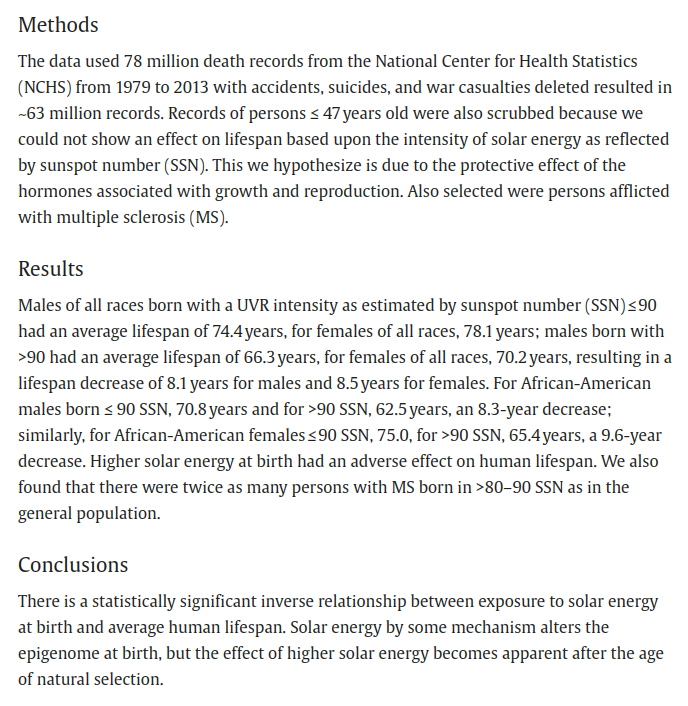
63 million death records across 34 years reveal a striking relationship between average lifespan and sunspot numbers at birth: those born in months with SSN≤90 live, on average, 8-10 years (around 11%-15%) longer than those born in months with an SSN>90. Source.
By consensus, the geomagnetic field is modulated in more or less equal proportions by processes at the core-mantle boundary and by exogenetic agencies, notably the solar wind. Accordingly, any modulation of solar wind should be identifiable in the geomagnetic moment.
- Long-term variance of solar wind is demonstrated notably by two proxies: documentary evidence of aurora sightings in Europe, the Middle East and China; and cosmic-ray generated C-14 flux rate as determined from tree rings, the rate being inversely related to solar activity which modulates the Earth’s magnetosphere “umbrella”.
- The planetary “Pulse of the Solar System” is controlled by the combined angular momentum maintained by Saturn and Jupiter (together representing 86% of the planetary total); their beat frequency (or lap rate) is 19.859+/-0.82 yr. Other planetary alignments correlate with other well-known cycles.
- A roughly 20-yr periodicity is found in innumerable terrestrial climate and geophysical proxies, which imply a role for solar radiation. Linkage between the Saturn-Jupiter Lap and solar behavior is demonstrated by spectral analyses of both sunspot numbers and solar angular momentum. However, the existence of any common relationship is not universally accepted.
- The further link between solar activity and terrestrial climates is also controversial. Several mechanisms may be involved, for example: (a) radiative UV modulation of stratospheric ozone and the height of the tropopause (fluctuating with the 11-22 yr solar cycles), thence triggering tropospheric disturbances such as the Quasibiennial Oscillation (QBO) which in turn influences to some extent the Southern Oscillation and El Nino phenomena, the Asiatic Monsoon and other global circulation systems (Fairbridge, 1990); (b) particulate radiation, especially the high proton and X-ray flux at high-energy solar flare peaks, seems to play an important role in the region of the magnetic poles affecting atmospheric chemistry and density, triggering high-latitude geomagnetic disturbances.
- The Earth’s spin rate (or length of day, LOD) is closely related to the geomagnetic field, and/or vice versa. Annual variability is commonly explained by seasonal climatic systems. Solar periods of around 11 and 22 yr are more controversial and may be explained either by a climatic intermediary or by the planetary angular momentum alignment, which is difficult to demonstrate. Longer-term variances in the magnetic field are customarily attributed to core-mantle mechanisms, but exogenetic correlations are not ruled out.
- The Moon’s 28-day cycle is well established, creating the “Pulse of the Earth-Moon Pair,” but its 18.6-yr nodal or declination cycle is more important for long-term relationships, insofar as it forces the nutation of the Earth’s spin axis. This period is therefore recorded in the geomagnetic moment and aurora sightings, a fact first documented in Sweden, 90 years ago, by Ekholm & Arrhenius (1898). Arguments for a nutation-climate linkage, however, are not universally persuasive: all for in-depth research.
- The Moon’s gravitational attraction develops diurnal oceanic tides, but also creates a standing wave in the atmosphere which is modulated further by the 18.6 yr period. Precipitation values in Bavaria were first identified as being influenced by this factor in a paper by Georg Schübler (dated 1839). The 18.6 yr period is now recognised worldwide in analyses of precipitation, atmospheric pressure, mean sea level, ocean currents and so on (Currie, 1987).
- Combined luni-solar tidal attraction develops the maximum potential tide-raising force, which on average is reached 4 yr after the nodal/ declination maximum (not before, as stated in error: Fairbridge & Sanders, 1987, p. 446). This potential is augmented by perihelion-perigee-syzygy alignments, to develop cycles of 4.425, 8.849, 31.008, 62.013,93.012, 111.05, 222.103, 558.12 yr, etc.
- The fundamental tides are 1.132 yr (the “lunar evection tide”) and 18.030 yr (the “principal perigee-syzygy tide”). The former relates to the Chandler Wobble which in turn develops a beat frequency with the Earth’s annual period, averaging 6.2 yr. This 6.2 yr beat period is represented in numerous climate-related time series, notably precipitation and tree rings. It is approximately one third of the 18.6 yr period and almost in phase with the perihelion-node-apsides cycle every tenth harmonic with a major tidal effect every 62.013 yr. It is thus commensurable with low frequency lunar harmonics, e.g. 93.012, 186.1, etc. The Chandler beat is slightly variable because of the wobble variance but is generally 17-18 months ahead of the corresponding 18.61 yr nutation maximum.
- A beat frequency of 576.6 yr develops between the 18.61 and 18.03 yr lunar periods (approx. in phase: A.D. 1857.7). It is also an exact multiple of the 6.2 yr (x 93) Chandler Wobble beat and the Solar System’s SJL of 19.86 yr (x 29). Another lunar beat frequency is the 179.3 yr period that is developed by that 18.61 yr and 8.849 yr (apsides) cycles. The two were almost in phase in AD 1987.8, 1801.7, and 1615.6. Perhaps the most striking proxy that this has uncovered is the 500 yr El Nino return frequency: traced over nearly 500 yr, it shows a systematic recurrence with combinations of the four lunar periodicities: 4.45, 6.2, 18.03 and 18.61, and a predictable return at 179 and 186 yr separations (Fairbridge, 1990).
- Finally there is a luni-solar beat of 297.8 yr composed of the two major periods: 18.61 yr (x 16) and 19.86 yr (x 15). The two were almost in phase in AD 1801.7 (also with the 8.849 yr apsides cycle and (roughly) with the 6.2 yr Chandler beat). Low-frequency harmonics of the 297.8 yr beat are commensurable with major Sun and solar system periods, e.g. 3 x 297.8 = 893 yr (5 x 178.71); 9 x 297.8 = 2680.3 (the “Jupiter-Saturn Resonance Drift” of Worth & Schlamminger, 1979). This intimate commensurability between lunar, terrestrial and planetary-solar periods can hardly be an accidental coincidence but seems to call for a systematic gravitational interrelation- ship. But there are still some VERY BIG unknowns. A veritable gold mine of research offers challenges for the future. As the Danish physicist Niels Bohr observed when someone asked why he nailed a horse-shoe over his door — “Of course I don’t believe it, but some folk say it works.”
Curated from Planetary Beats & Geology
by Rhodes W. Fairbridge (1988), as published in
New Approaches in Geomagnetism and the Earth’s Rotation
Edited by Stig Flodmark
This animation shows a representation of the orbits and movements of the planets in the TOI-178 system. New research by Adrien Leleu and his colleagues with several telescopes, including ESO’s Very Large Telescope, has revealed that the system boasts six exoplanets and that all but the one closest to the star are locked in a rare rhythm as they move in their orbits (represented in orange). In other words, they are in resonance. This means that there are patterns that repeat themselves rhythmically as the planets go around the star, with some planets aligning every few orbits. – European Southern Observatory, Chile
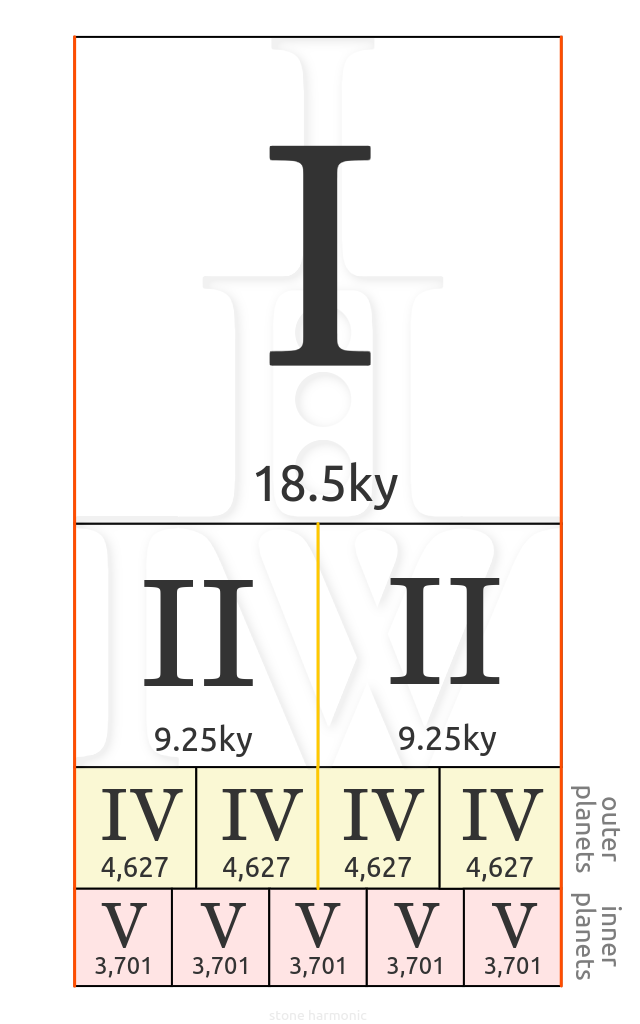 The JUNS Harmonic
The JUNS Harmonic
The JUNS Orbital Cycle (Jupiter-Uranus-Neptune-Saturn) has a grand period of ~4627 years before all four repeat their dance. The 4/5 harmonic of this period is ~3702 years. If we look back through time, we find something quite remarkable every 3.7ka, going back not to the YDB, but one more cycle to the start of the Bølling–Allerød Interstadial 14.8ky before the present.
3700 Years
“Among the artifacts that can most readily be dated by astronomical techniques are depictions of the positions of the celestial bodies at a particular time. Since the motions of the celestial bodies are all at different periods, it takes many centuries for all the planets plus the Sun and the Moon, to reach the same positions in the signs of the Zodiac. For a configuration accurate to ±15° (that is, within a single sign) the positions of these seven bodies will only return to the same configuration once in about 3700 years.”
“A team of archaeologists has discovered the well-preserved brain and skin remnants of people who lived around 3,700 years ago in Turkey. The remains belong to two Bronze Age individuals who were found at the Tavşanlı Mound (or Tavşanlı Höyük) in Turkey’s Kütahya province—located in the west of the Anatolian peninsula. The remnants belong to a young man aged 15-18 at the time of death, and another middle-aged man who was 40-45 years old when he died, the Anadolu Agency (AA) reported. Researchers believe these individuals died when their homes were set on fire and they were unable to flee during an attack around 3,700 years ago. Evidence suggests there was a large-scale attack on the city around 1700 B.C. that resulted in the entire settlement being burned to the ground.”
– Archeologists Discover Brain Remnants of People Who Lived 3,700 Years Ago, Newsweek
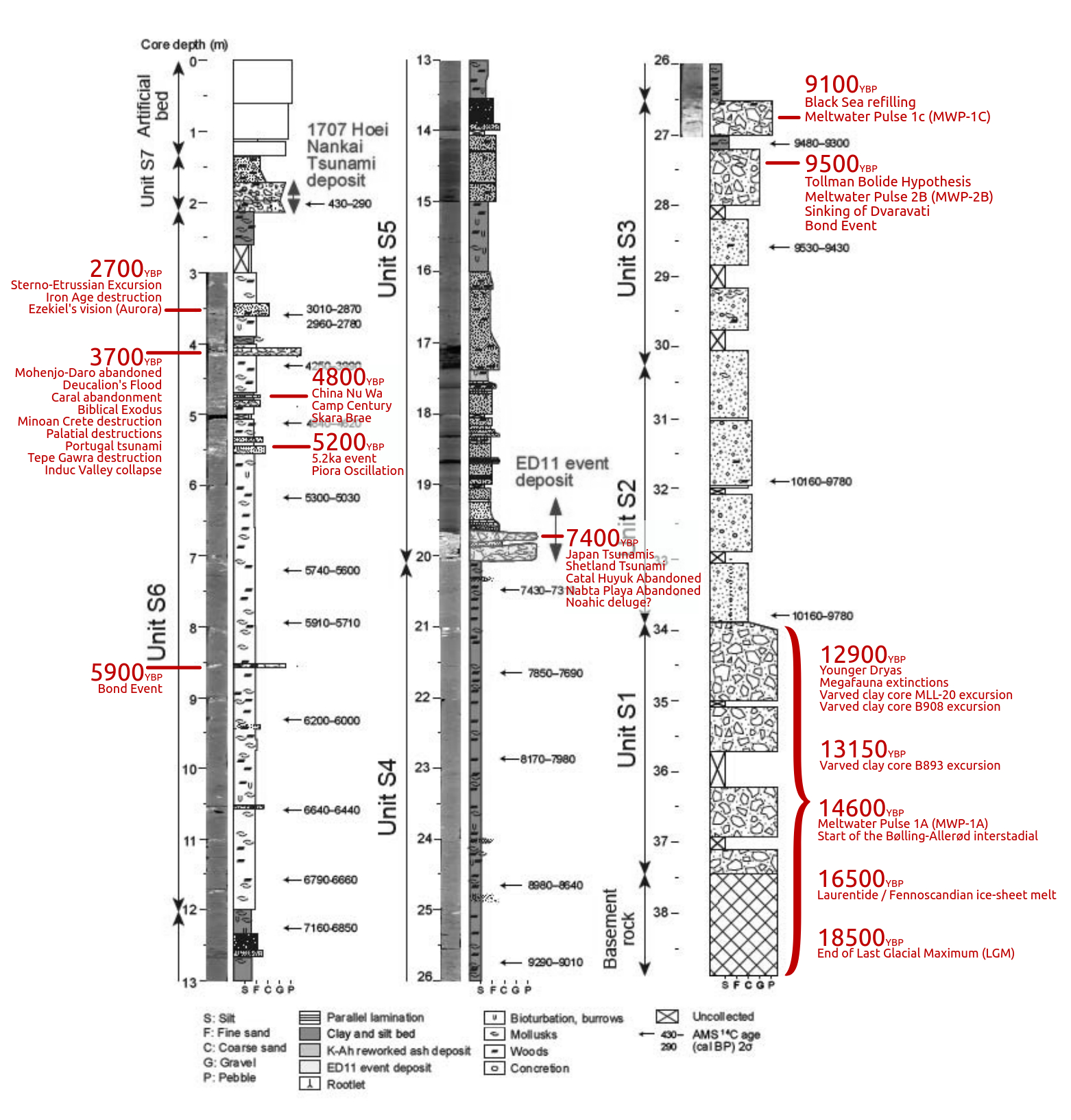
two consecutive massive tsunami deposits c.7300 YBP. The 10ka core dating correlates with a significant number of known geophysical events (my additions in red), including several JUNS timeline event confirmations. Source.
“About 3700 years ago, as Mesopotamian poets were composing the “Epic of Gilgamesh,” the last woolly mammoths on Earth were making their last stand on a remote Arctic island. A terminal colony persisted on tiny Wrangel Island north of the Siberian mainland thousands of years after the rest of its kind had disappeared. Now, a new study reveals the mammoths’ horrific final days: A series of harmful genetic mutations appears to have led to what authors call a “genomic meltdown” in the population.”
– The last, lonely woolly mammoths faced a ‘genomic meltdown’, Science
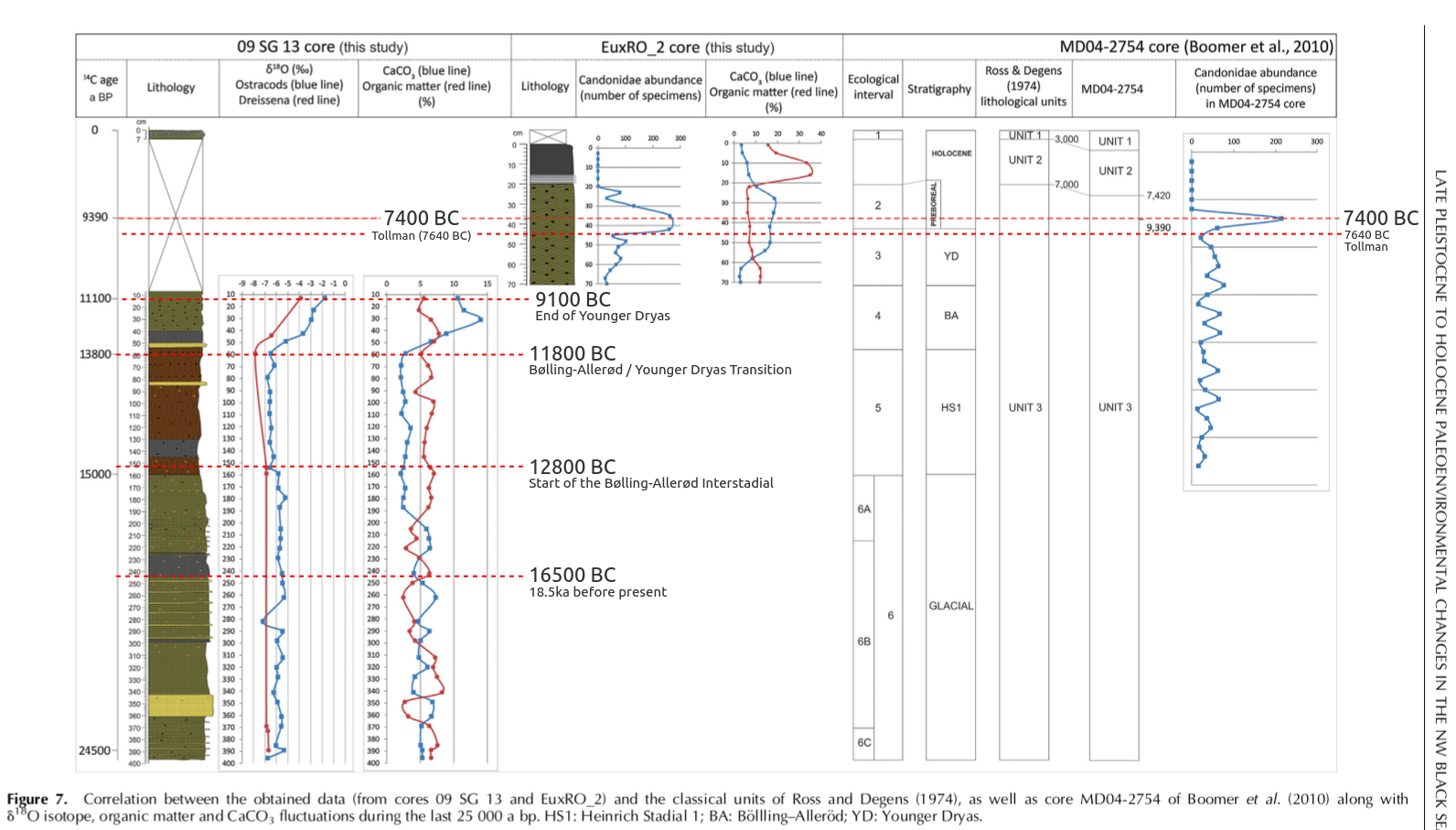
Black Sea 25ka reconstructions. The top dotted orange line is original (not added by me). Source.
Crete (1750-1700 B.C)
The Isle of Crete in the blue waters of the Mediterranean, with its precipitous reddish, rocky shores, a silent monument of a world that has passed, was three millennia ago a great center of an unusually rich culture. The Minoan scripts are now in the process of being deciphered; the clue was discovered by Michael Ventris, an English architect.
The history of ancient Crete – or of the Minoan culture on it – is divided into Early, Middle, and Late Minoan ages, corresponding in time with the Old, Middle, and New Kingdoms in Egypt. The period of the Hyksos in Egypt, between the Middle and the New Kingdoms, coincides with the last – the third – subdivision of Middle Minoan.
All the great periods in Minoan Crete terminated in natural catastrophes. The monumental work of Sir Arthur Evans, The Palace of Minos at Knossos, furnishes abundant evidence of the destructive nature of the disruptive agent that brought to a close the ages of Minoan culture, one after the other. He speaks of a “great catastrophe” that took place toward the close of Middle Minoan II. “A great destruction” befell Knossos on the northern shore of the island and Phaestos on its southern shore. The isle lay prostrate, overwhelmed by the elements.
When, finally, the survivors or their descendants began the work of restoration, their labor was destroyed again in an “overthrow.” Barely half a century passed between these two catastrophes: one synchronical with the end of the Middle Kingdom in Egypt and the Exodus – the other, one or two generations later.
In the later phase of Middle Minoan III the phenomena “conclusively point to a seismic cause for the great overthrow that befell the Palace and surrounding Town.” “Throughout the exposed areas of the building [palace] there is evidence of a great overthrow, burying with it a long succession of deposits. …”
At the end of the next age, Late Minoan I, the existence of the palace of Knossos “was cut short by some extraneous cause, though without any such signs of wholesale ruin as seem to have marked its earlier disaster.” However, Marinatos, director of the Greek Archaeological Service, finds: “The catastrophe of Late Minoan I was fatal and general throughout the whole of Crete. It seems certain that it was the most terrible of all which occurred on the Island.” The palace at Knossos was destroyed. “The same tragedy befell all the so-called mansions. … Whole cities, too, were destroyed. … Even sacred caves fell in like the one at Arkalokori.” Volcanic ash fell on the island and great tidal waves moved toward the island from the north and swept over it. In this catastrophe Crete received “an irreparable blow.” “Earthquake is one of the natural causes; a normal earthquake, however, is wholly insufficient to explain so great disaster.”
Then came the destruction of Late Minoan II. The sudden catastrophe interrupted all activity; but there are indications also that, though the upheaval was instantaneous, some preparations had been made in an effort to appease the deity for fear of the impending event. Evans writes: “It would seem that preparations were on foot for some anointing ceremony. … But the initial task was never destined to reach its fulfillment.” Beneath a covering mass of earth and rubble lies the “Room of the Throne” with alabaster vessels. “The sudden breaking off of tasks begun – so conspicuous … surely points to an instantaneous cause.” It was “another of those dread shocks that had again and again caused a break in the Palace history.” The earthquake was accompanied by fire. The actual overthrow was greatly aggravated by “a widespread conflagration” and the catastrophe attained “special disastrous dimensions owing to a furious wind then blowing.” Evans assigns the final destruction of the building to the month of March. The disaster, however, did not approach in magnitude that “which, for example, had put an end to the building in its Middle Minoan age.”
After this last catastrophe the palace at Knossos was never again rebuilt.
– Earth in Upheaval, Immanuel Velikovsky (1977 edition)
Mohenjo-Daro (~1700 BC)
Built c. 2500 BCE, it was the largest settlement of the ancient Indus Valley Civilization, and one of the world’s earliest major cities, contemporaneous with the civilizations of ancient Egypt, Mesopotamia, Minoan Crete, and Norte Chico. With an estimated population of at least 40,000 people, Mohenjo-daro prospered for several centuries, but by c.1700 BCE had been abandoned, along with other large cities of the Indus Valley Civilization. The city also had large platforms perhaps intended as defense against flooding. According to a theory first advanced by Wheeler, the city could have been flooded and silted over, perhaps six times, and later rebuilt in the same location. For some archaeologists, it was believed that a final flood that helped engulf the city in a sea of mud brought about the abandonment of the site.
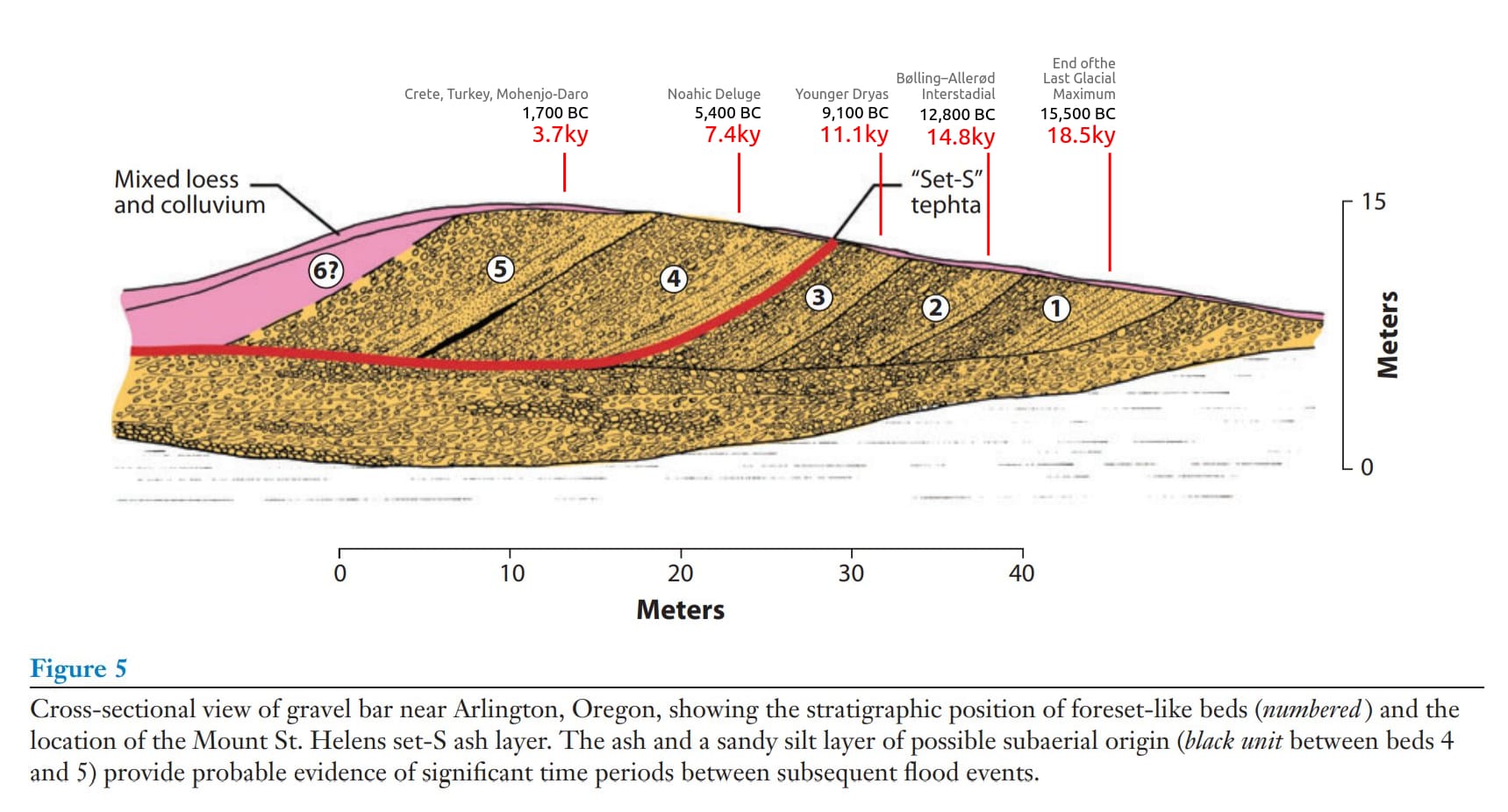
Channelled Scablands flood deposit sequence through the lens of the 3,700-year cycle. The “Set S” tephta is an ash layer from Mt. Saint Helens and is a temporal marker for the termination of the Younger Dryas. Dating text in red, black and grey added by me. Source.
Velikovsky & Sitchin
Immanuel Velikovsky demonstrated rather convincingly that there was massive evidence of both a literary and scientific nature that great catastrophic earth changes had occurred during the second millennium BC due to cometary showers and the close passage of Venus. He settled on a date of 1450 BC, but more recent scientific evidence points to the date actually being between 1644 and 1600 BC. There is also evidence for a disruption circa 5200 BC, 8,800 BC, 12,400 BC, 16,000 BC, 19,600 BC, and by logical extension every 3,600 years previously for an indefinite and unknown period of time. What is more, if the last “return” was in 1600 BC, we are not just due, we are overdue for the next one. Sitchin’s theories about Nibiru do not take into account many of the literary reports from the ancients regarding these great bombardments of comets.
Velikovsky tried to account for this by suggesting that a cometary Venus was hauling around a tail of rocks. It seems that Velikovsky and his supporters, and Sitchin and his supporters, although recognizing serious worldwide catastrophes, have failed to recognize the true nature of such events. Velikovsky proposed that Venus out of orbit was a more or less one-time event rather than a symptom of a long-term cycle. Sitchin came closer with his understanding of the cycle, but he failed to consider all the variables in his solution. What is more, once he settled on his idea as the one and only solution, his efforts to make the mythical elements fit the hypothesis became almost as absurd as the efforts of mainstream science to avoid them!
The confirmed linchpin for the fall of the late Bronze Age cultures, the Middle Eastern Civilizations, and other recorded disasters that are found to be “around that time”, seems to be the period from 1644 BC to 1600 BC. The ice cores show the disturbances starting in 1644 (registering in 1645), and the tree rings show a big spike in 1628, though the entire period was disturbed. What is clear is that whatever comes at 3600 year intervals as shown by the ice cores is capable of setting off prolonged periods of earth changes that are above the levels of ordinary uniformitarian geologic and climatalogical changes. But what is important is that the mythical and archaeological evidence suggests that it is a shower of asteroids or comets that are NOT seen until it is TOO LATE.
To ascribe all of the evidence of cyclic catastrophe to a “uniformitarian” idea that it just got cold and then got warm and got cold and warm… with such an evident cycle is sort of absurd. To ascribe it to a “galactic core explosion” is equally absurd.
I think that, based on the observations of the ancients that what we are looking for is a recurring shower of comets that cycles through the solar system regularly, on a 3,600-year orbit. What is more, it seems that this body of comets, clustered together, at some point, resembles a fiery serpent with a mouthful of devouring teeth in the blackness of space.
– The Secret History of the World, Laura Knight-Jadczyk
Harmonic Convergence
I have compiled a database of more than 300 events from various proxies and periods. An age-weighted count of entries starts to reveal several peaks which coincide with planetary harmonics. Notable periods are 2.5ka, 3.7ka, 4.0ka, 4.6ka and multiples thereof.
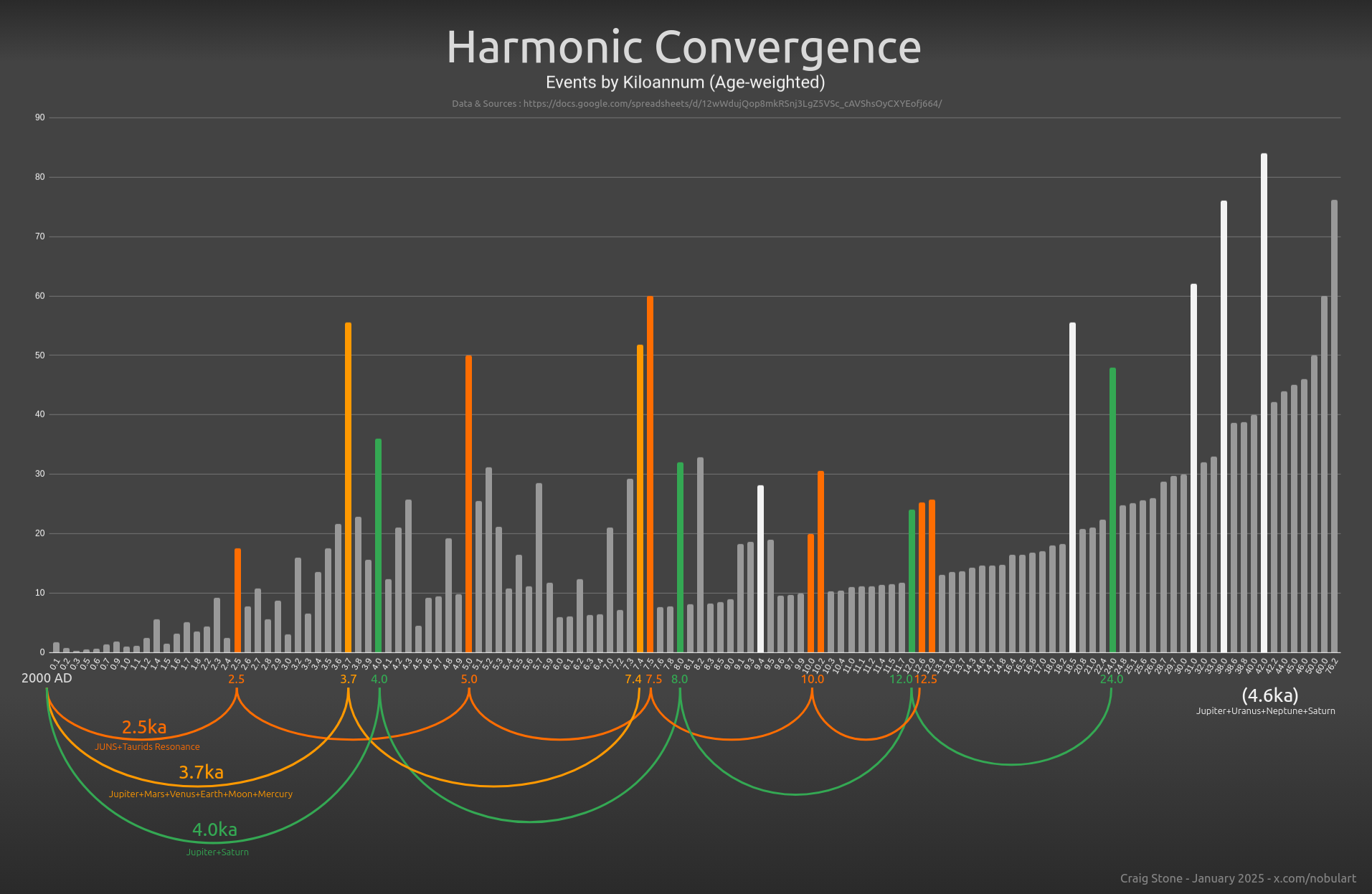
Age-Weighted Harmonic Convergence. Source.
The Landscheidt Minimum
Sun-Earth-Man by Theodor Landscheidt
There is ever-mounting evidence warning the next epoch will be one of sharp terrestrial cooling due to a relative flat-lining of solar output. The exact time-frame and depth of this next chill of solar minimum is still anyone’s guess, and the parameters involved (i.e., galactic cosmic rays, geomagnetic activity, solar wind flux etc.) remain poorly understood. However, there are some great minds on the job, and below I’ve collated 11 best-guesses based on published scientific papers from respected researchers in the field. The list begins with eminent Russian astrophysicist K. Abdussamatov–though it is in no particular order.
- ABDUSSAMATOV (2016) : The quasi-centennial epoch of the new Little Ice Age has started at the end 2015 after the maximum phase of solar cycle 24. The start of a solar grand minimum is anticipated in solar cycle 27 ± 1 in 2043 ± 11 and the beginning of phase of deep cooling in the new Little Ice Age in 2060 ± 11.
- ZHARKOVA (2020) : The Sun has entered into the modern Grand Solar Minimum (2020–2053) that will lead to a significant reduction of solar magnetic field and activity like during Maunder minimum leading to noticeable reduction of terrestrial temperature.
- SANCHEZ-SESMA (2016) : This empirical modeling of solar recurrent patterns has also provided a consequent multi-millennial-scale experimental forecast, suggesting a solar decreasing trend toward grand (super) minimum conditions for the upcoming period, AD 2050–2250 (AD 3750–4450).
- SÁNCHEZ-SESMA (2015) : These millennial-scale patterns of reconstructed solar activity variability could justify epochs of low activity, such as the Maunder Minimum, as well as epochs of enhanced activity, such as the current Modern Maximum, and the Medieval Maximum in the 12th century.
- MÖRNER (2015) : By about 2030-2040, the Sun will experience a new grand solar minimum. During the previous grand solar minima—i.e. the Sporer Minimum (ca 1440-1460), the Maunder Minimum (ca 1687-1703) and the Dalton Minimum (ca 1809-1821)—the climatic conditions deteriorated into Little Ice Age periods.
- MÖRNER (2018) : Several scientists (e.g. [Landscheidt, 2003] [Charvátová, 2009] [Mörner, 2010] [ Mörner, 2015] [Abdussamatov, 2016]) have shown that we, in fact, are approaching a New Grand Solar Minimum in about 2030-2050. In analogy with the documented climate conditions during the Spörer, Maunder and Dalton Minima, we may expect the return of a New Little Ice Age.”
- BIANCHINI AND SCAFETTA (2018) : A simple harmonic model based on the 9.98, 10.9 and 11.86 year oscillations hindcast reasonably well the known prolonged periods of low solar activity during the last millennium such as the Oort, Wolf, Sporer, Maunder and Dalton minima.
- MCCRANN ET AL. (2018) : The effect of the Sun’s activity on Earth’s climate has been identified since the 1800s. In agreement with many studies that have identified a 60-year cycle in the variation of Earth’s temperature, it is expected that surface temperatures will reach a trough of the cycle around 2030-2040.
- YNDESTAD AND SOLHEIM (2017) : Deterministic models based on the stationary periods confirm the results through a close relation to known long solar minima since 1000 A.D. and suggest a modern MAXIMUM period from 1940 to 2015. The model computes a new Dalton-type sunspot MINIMUM from approximately 2025 to 2050
- FLEMING (2018) : The cause of the Medieval Warm Period and the Little Ice Age climate changes was the solar magnetic field and cosmic ray connection. When the solar magnetic field is strong, it acts as a barrier to cosmic rays entering the Earth’s atmosphere, clouds decrease and the Earth warms.
- ABDUSSAMATOV (2012) :
– 11 Scientific Predictions for the Upcoming Grand Solar Minimum


